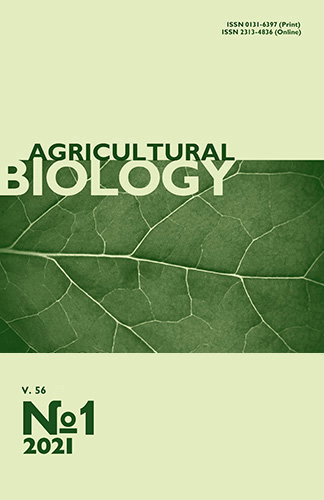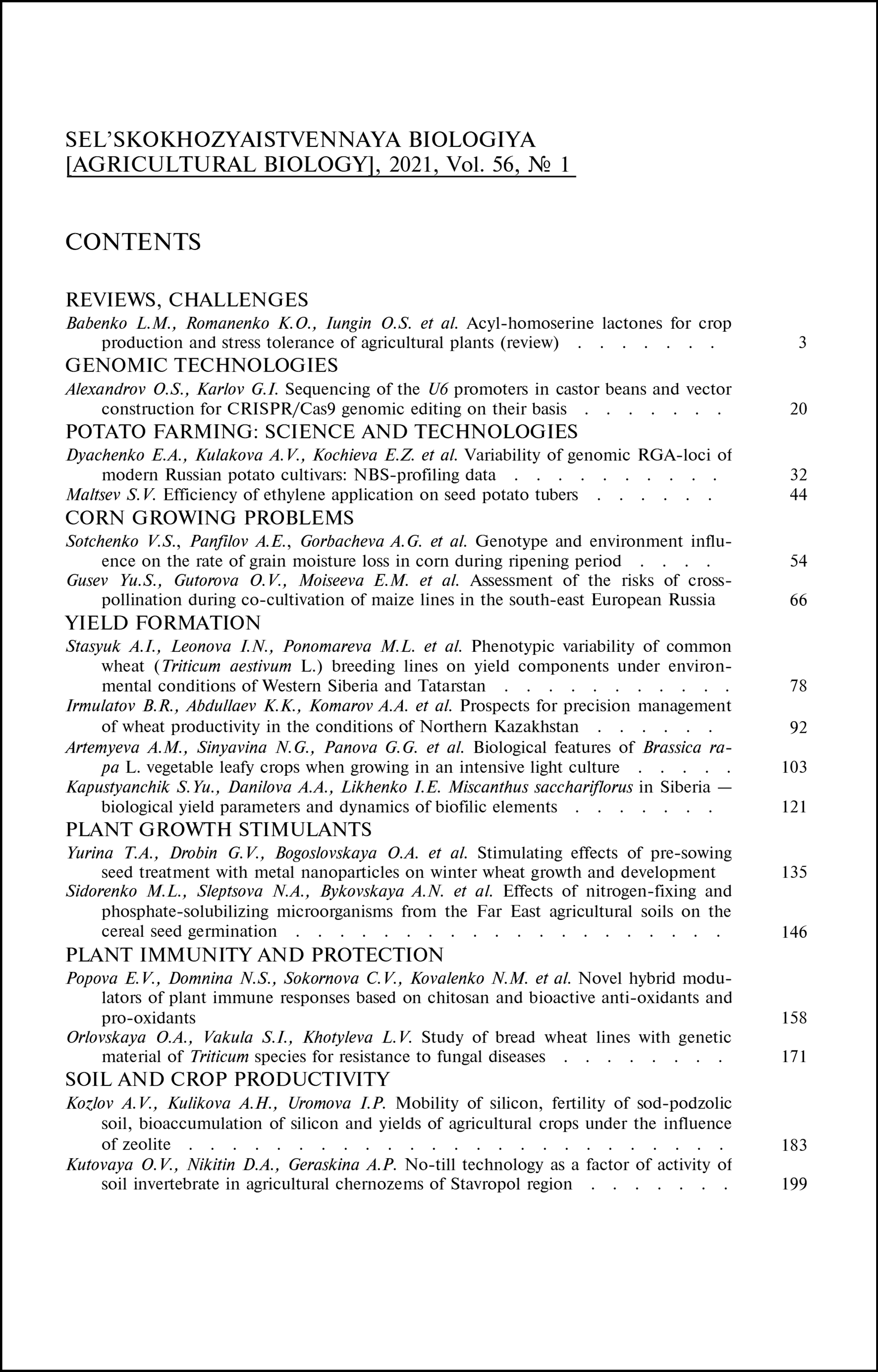doi: 10.15389/agrobiology.2021.1.20eng
UDC: 633.853.55:575.1:577.21
Acknowledgements:
Supported by the Russian Science Foundation, Agreement No. 17-74-10233 dated July 21, 2017 on the scientific project “Adaptation of the CRISPR/Cas9 genomic editing technology elements to improve a castor bean (Ricinus communis L.) genome”
SEQUENCING OF THE U6 PROMOTERS IN CASTOR BEANS AND VECTOR CONSTRUCTION FOR CRISPR/Cas9 GENOMIC EDITING ON THEIR BASIS
O.S. Alexandrov ✉, G.I. Karlov
All-Russian Research Institute of Agricultural Biotechnology, 42, ul. Timiryazevskaya, Moscow, 127550 Russia, e-mail olegsandrov@gmail.com (✉ corresponding author), karlovg@gmail.com
ORCID:
Alexandrov O.S. orcid.org/0000-0002-7146-4094
Karlov G.I. orcid.org/0000-0002-9016-103X
Received July 13, 2020
Castor bean is an important crop in many countries. It is mainly used to obtain the castor oil, which is widely applied in various industries. The rich protein cakes and meals are remains after the oil is pressed. They are promising for use as protein additives in the fodder production. However, it is limited due to the presence of toxins. These are ricin protein and ricinine alkaloid. One of such methods can be genomic editing using the CRISPR/Cas9 system. The technology consists in cutting the target region of the intact DNA by the Cas9 enzyme with the assistance of a short guide RNA fragment. The delivery of the Cas9 and guide RNA genes into the cell of the edited plant is often carried out by plasmid vectors. For efficient synthesis of the guide RNA in such vectors, the promoters of small nuclear RNA genes are usually used. In dicotyledonous plants editing, the promoter of the Arabidopsis U6 gene is most often used. In this work, the amplification, sequencing and analysis of the castor bean U6 promoters were carried out at the first time. The obtained sequences were analyzed and used in the construction of CRISPR/Cas9 vectors for the ricin gene editing. Our aim was to study castor bean U6 promoters with help by bioinformatics and molecular genetic approaches. Zanzibar Green and Gibzonskaya varieties of castor bean plants were used in this work. DNA was isolated from young leaves. The preparation of sequences, alignments and homology level calculation were carried out by GenDoc program (http://www.nrbsc.org/gfx/genedoc/index.html). Primers for amplification of castor bean U6 promoters were designed by Primer3 program (http://bioinfo.ut.ee/primer3-0.4.0/). PCR was performed using a C-100 PCR machine (Bio-Rad Laboratories, Inc., USA). PCR products were separated in 1.5 % agarose gel at 6 B/cm in the Sub-Cell GT electrophoresis camera (Bio-Rad Laboratories, Inc., USA). The amplicons were purified with the GeneJET PCR Purification Kit (Thermo Fisher Scientific, Inc., USA). The purified amplicons were cloned into the pAL2-T vector (Evrogen, Russia) according to protocol of manufacturer. In the CRISPR/Cas9 vector construction, the pRGE31, HindIII and SbfI restriction enzymes (Sibenzyme, Russia) and nucleotides were used. Purification of the digested products was carried out with the GeneJET Gel Extraction Kit (Thermo Fisher Scientific, Inc., USA). Bioinformatic search were conducted in the GenBank base, and 12 scaffolds with the castor bean U6 gene were found. Six promoters with intact USE and TATA-box elements of regulation were used in the primer design for amplification with cv. Zanzibar Green and cv. Gibzonskaya DNA matrices. One fragment PCR products were cloned and sequenced. The analysis of the obtained amplicon sequences reveled that promoter regions of two studied varieties were similar. The level of promoter identity from different amplicons ranged within 51-77 %. In comparison of these promoters with ones from other plants, the level of homology was 42-64 %. The promoter sequences with intact USE and TATA-box motifs were used in construction of the CRISPR/Cas9 vectors which can be used for efficient editing of the castor bean genes involved in the ricin and ricinine synthesis.
Keywords: castor beans, promoter, U6 gene, sequencing, genome editing, CRISPR/Cas9, vector construction.
REFERENCES
- Moshkin V.A. Kleshchevina [Castor beans]. Moscow, 1980 (in Russ.).
- Aznaur'yan M.P., Eloshvili N.G., Nazarov N.V., Yakubovich H.H., Meshcheryakov C.B., Girsin Yu.A. Izvestiya vuzov, Pishchevaya tekhnologiya, 1993, 1-2(212-213): 87-89 (in Russ.).
- Naughton F.C. Production, chemistry and commercial applications of various chemicals from castor oil. Journal of the American Oil Chemists' Society, 1974, 51(3): 65-71 CrossRef
- Shul'pekova Yu.O. Prilozhenie RMZH «Bolezni organov pishchevareniya», 2006, 8(2): 90-96 (in Russ.).
- Anandan S., Kumar G.K.A., Ghosh J., Ramachandra K.S. Effect of different physical and chemical treatments on detoxification of ricin in castor cake. Animal Feed Science and Technology, 2005, 120(1-2): 159-168 CrossRef
- Gusynin I.A. Toksikologiya yadovitykh rastenii [Toxicology of poisonous plants]. Moscow, 1962 (in Russ.).
- Ishino Y., Krupovic M., Forterre P. History of CRISPR-Cas from encounter with a mysterious repeated sequence to genome editing technology. Journal of Bacteriology, 2018, 200(7): e00580-17 CrossRef
- Zlobin N.E., Ternovoi V.V., Grebenkina N.A., Taranov V.V. Vavilovskii zhurnal genetiki i selektsii, 2017, 21(1): 104-111 CrossRef (in Russ.).
- Andersson M., Turesson H., Nicolia A., Fält A.S., Samuelsson M., Hofvander P. Efficient targeted multiallelic mutagenesis in tetraploid potato (Solanum tuberosum) by transient CRISPR-Cas9 expression in protoplasts. Plant Cell Reports, 2017, 36(1): 117-128 CrossRef
- Sun X., Hu Z., Chen R., Jiang Q., Song G., Zhang H., Xi Y. Targeted mutagenesis in soybean using the CRISPR-Cas9 system. Scientific Reports, 2015, 5: 10342 CrossRef
- Long L., Guo D.D., Gao W., Yang W.W., Hou L.P., Ma X.N., Miao Y.C., Botella J.R., Song C.P. Optimization of CRISPR/Cas9 genome editing in cotton by improved sgRNA expression. Plant Methods, 2018, 14: 85 CrossRef
- Yan P.U., Chao L.I.U., JiYang L.I., TaShi A., Yan H.U., XiaoDong L.I.U. Different SlU6 promoters cloning and establishment of CRISPR/Cas9 mediated gene editing system in tomato. Scientia Agricultura Sinica, 51(2): 315-326.
- Bernard G., Gagneul D., Dos Santos H.A., Etienne A., Hilbert J.-L., Rambaud C. Efficient genome editing using CRISPR/Cas9 technology in chicory. International Journal of Molecular Sciences, 2019, 20(5): 1155 CrossRef
- Marshallsay C., Kiss T., Filipowicz W. Amplification of plant U3 and U6 snRNA gene sequences using primers specific for an upstream promoter element and conserved intragenic regions. Nucleic Acids Research, 1990, 18(12): 3459-3466 CrossRef
- Chan A.P., Crabtree J., Zhao Q., Lorenzi H., Orvis J., Puiu D., Melake-Berhan A., Jones K.M., Redman J., Chen G., Cahoon E.B., Gedil M., Stanke M., Haas B.J., Wortman J.R., Fraser-Liggett C.M., Ravel J., Rabinowicz P.D. Draft genome sequence of the oilseed species Ricinus communis. Nature Biotechnology, 2010, 28: 951-956 CrossRef
- Horvath D.P., Patel S., Doğramaci M., Chao W.S., Anderson J.V., Foley M.E., Scheffler B., Lazo G., Dorn K., Yan C., Childers A., Schatz M., Marcus S. Gene space and transcriptome assemblies of leafy spurge (Euphorbia esula) identify promoter sequences, repetitive elements, high-quality markers, and a full-length chloroplast genome. Weed Science, 2018, 66(3): 355-367 CrossRef
- Rahman A.Y., Usharraj A.O., Misra B.B., Thottathil G.P., Jayasekaran K., Feng Y., Hou S., Ong S.Y., Ng F.L., Lee L.S., Tan H.S., Sakaff M.K., Teh B.S., Khoo B.F., Badai S.S., Aziz N.A., Yuryev A., Knudsen B., Dionne-Laporte A., Mchunu N.P., Yu Q., Langston B.J., Freitas T.A., Young A.G., Chen R., Wang L., Najimudin N., Saito J.A., Alam M. Draft genome sequence of the rubber tree Hevea brasiliensis. BMC Genomics, 2013, 14: 75 CrossRef
- Wang W., Feng B., Xiao J., Xia Z., Zhou X., Li P., Zhang W., Wang Y., Møller B.L., Zhang P., Luo M.C., Xiao G., Liu J., Yang J., Chen S., Rabinowicz P.D., Chen X., Zhang H.B., Ceballos H., Lou Q., Zou M., Carvalho L.J., Zeng C., Xia J., Sun S., Fu Y., Wang H., Lu C., Ruan M., Zhou S., Wu Z., Liu H., Kannangara R.M., Jørgensen K., Neale R.L., Bonde M., Heinz N., Zhu W., Wang S., Zhang Y., Pan K., Wen M., Ma P.A., Li Z., Hu M., Liao W., Hu W., Zhang S., Pei J., Guo A., Guo J., Zhang J., Zhang Z., Ye J., Ou W., Ma Y., Liu X., Tallon L.J., Galens K., Ott S., Huang J., Xue J., An F., Yao Q., Lu X., Fregene M., López-Lavalle L.A., Wu J., You F.M., Chen M., Hu S., Wu G., Zhong S., Ling P., Chen Y., Wang Q., Liu G., Liu B., Li K., Peng M. Cassava genome from a wild ancestor to cultivated varieties. Nature Communications, 2014, 5: 5110 CrossRef
- Wu P., Zhou C., Cheng S., Wu Z., Lu W., Han J., Chen Y., Chen Y., Ni P., Wang Y., Xu X., Huang Y., Song C., Wang Z., Shi N., Zhang X., Fang X., Yang Q., Jiang H., Chen Y., Li M., Wang Y., Chen F., Wang J., Wu G. Integrated genome sequence and linkage map of physic nut (Jatropha curcas L.), a biodiesel plant. Plant Journal, 2015, 81(5): 810-821 CrossRef
- Halling K.C., Halling A.C., Murray E.E., Ladin B.F., Houston L.L., Weaver R.F. Genomic cloning and characterization of a ricin gene from Ricinus communis. Nucleic Acids Research, 1985, 13(22): 8019-8033 CrossRef
- Tregear J.W., Roberts L.M. The lectin gene family of Ricinus communis: cloning of a functional ricin gene and three lectin pseudogenes. Plant Molecular Biology, 1992, 18(3): 515-525 CrossRef
- Ladin B.F., Murray E.E., Halling A.C., Halling K.C., Tilakaratne N., Long G.L., Houston L.L., Weaver R.F. Characterization of a cDNA encoding ricin E, a hybrid ricin-Ricinus communis agglutinin gene from the castor plant Ricinus communis. Plant Molecular Biology, 1987, 9(3): 287-295 CrossRef
- Alexandrov O. Study of the upstream ricin gene sequences in different castor (Ricinus communis) varieties as a preliminary step in CRISPR/Cas9 editing. Research on Crops, 2020, 21(2): 344-348 CrossRef
- Aleksandrov O.S. Aktual'naya biotekhnologiya, 2018, 3(26): 161-162 (in Russ.).
- Doyle J.J., Doyle J.L. Isolation of plant DNA from fresh tissue. Focus, 1990, 12(1): 13-15.
- Razumova O.V., Alexandrov O.S., Divashuk M.G., Sukhorada T.I., Karlov G.I. Molecular cytogenetic analysis of monoecious hemp (Cannabis sativa L.) cultivars reveals its karyotype variations and sex chromosomes constitution. Protoplasma, 2016, 253(3): 895-901 CrossRef
- Wang M.B., Helliwell C.A., Wu L.M., Waterhouse P.M., Peacock W.J., Dennis E.S. Hairpin RNAs derived from RNA polymerase II and polymerase III promoter-directed transgenes are processed differently in plants. RNA, 2008, 14(5): 903-913 CrossRef
- Mikami M., Toki S., Endo M. Comparison of CRISPR/Cas9 expression constructs for efficient targeted mutagenesis in rice. Plant Molecular Biology, 2015, 88(6): 561-572 CrossRef
- Domitrovich A.M., Kunkel G.R. Multiple, dispersed human U6 small nuclear RNA genes with varied transcriptional efficiencies. Nucleic Acids Research, 2003, 31(9): 2344-2352 CrossRef
- Wang P., Zhang J., Sun L., Ma Y., Xu J., Liang S., Deng J., Tan J., Zhang Q., Tu L., Daniell H., Jin S., Zhang X. High efficient multisites genome editing in allotetraploid cotton (Gossypium hirsutum) using CRISPR/Cas9 system. Plant Biotechnology Journal, 2018, 16(1): 137-150 CrossRef












